42100 Liebherr R 9800: A second opinion
Posted by Huw,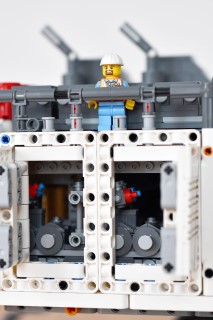
As you are hopefully aware, anyone can write set reviews here at Brickset simply by clicking on the 'review this set' link next to each entry in the set listings.
The number submitted has dropped dramatically since 2008, when over 5000 were contributed, presumably because nowadays people prefer to do video reviews on YouTube. Nevertheless, last year, around 1200 were written, and we are thankful to everyone that takes the time to do so.
Every now and again one catches our eye that is so good that it deserves wider exposure, such as this review of 42100 Liebherr R 9800 by martiniman which I reproduce here in its entirety:
To me the Liebherr R9800 excavator set is 3 things: an enormous realistic looking beast of a technic set, a truckload of useful parts in basic colours, and EV3 replacement potential thanks to the 2x4 port Bluetooth hubs. However, it has a serious flaw in the form of its limited playability, yet there is room to fix this main grief.
The machine is really impressive looking and pretty realistic. It dwarfs anything LEGO has made before in the Technic range, both in size and weight.
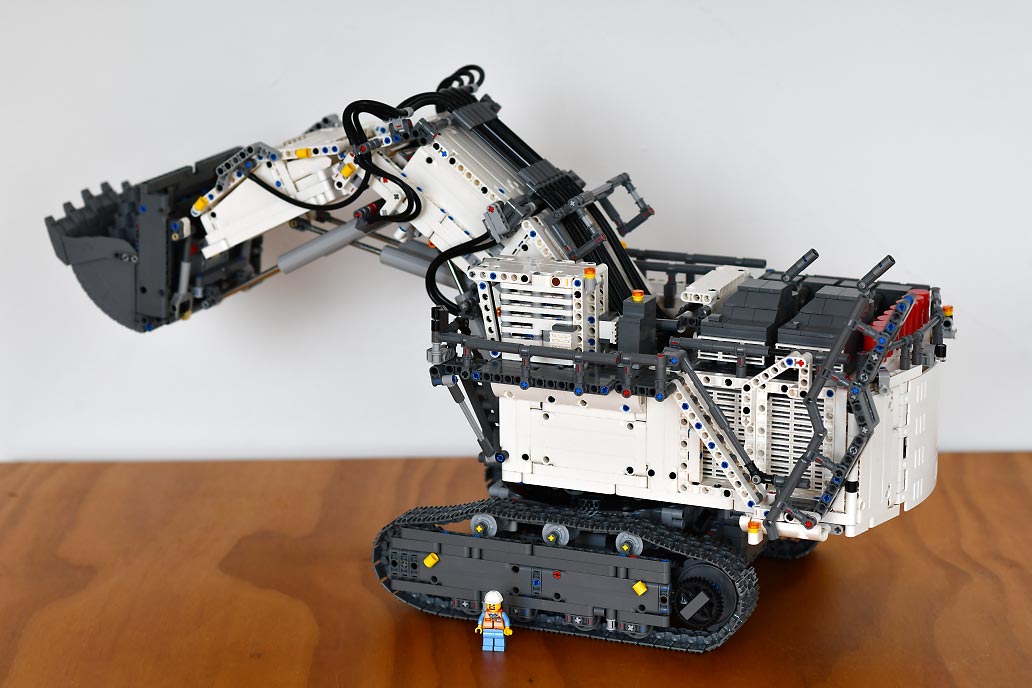
A classic minifig would be 1m65 next to the real R9800. The free space under the model is 96mm, the fig 44mm. The real free space is 3600mm, so at a 1:38 scale the man is 1m65. A little tiny, but it fits.
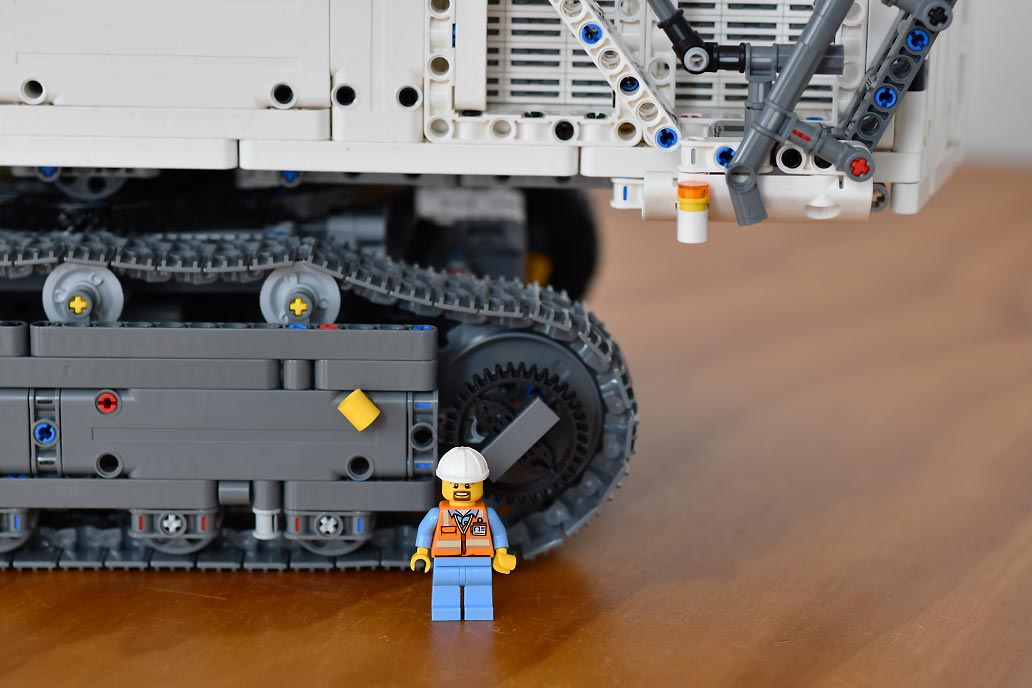
The parts are very useful, basic black, dark grey and white beams in big amounts and all lengths, ample 5x7 frames and the new 7x11 frames, 8 linear actuators of which 6 are in the new XL flavour, 7 motors, 2 Bluetooth hubs with 4 connectors each, tons of gears, turntables, axles, connectors.
I’ll dive into it later, but I have the idea the 2 Bluetooth hubs have great potential for creating EV3 like MOC’s. The hubs offer the basis for great interactive models. The hardware itself is decent. It allows 4 sensors and actuators to communicate with a Bluetooth based microcontroller and it has 2 sensors built in (3 axis gyro and 3 axis accelerometer). If you compare it with the similarly expensive EV3 set, this gives much more motors, and you can buy some sensors later. With the 2 hubs you get 8 multifunction ports where the EV3 brick has 4 sensor and 4 actuator ports. I think you can even hook up more hubs to a single microcontroller for even more complex robotic systems.
Unboxing and manual
The box is full of numbered bags. The spread over 5 building phases is a bit weird (phase 6 is just 100 round bricks as stone load). Bags 1-3 include much more than bags 4-6. Downside of the numerous plastic bags is that you end up with lots of waste. I would like to see LEGO use paper in the future.
The manual is split in 2, it is the usual good quality print on a little too thin paper. There are some hiccups in the manual. There are some strange jumps at the end, where you work on the fences around the edge of the vehicle, then switch to pneumatic tires and then return to some random parts of fence again. Also the tubing steps are all presented from one side, where the model is too big and too heavy in the final phase to work like this. I would have preferred to see the piping being done on one side first, and then on the other side.
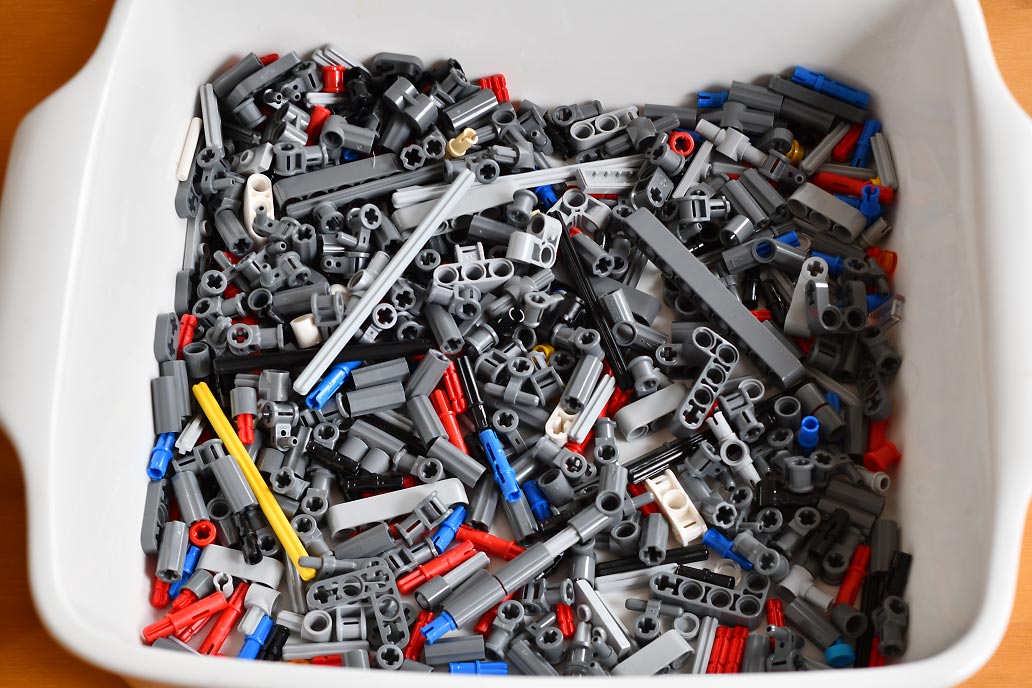
Dounting amount of similar looking bricks makes phase 5 tough for kids.
I understand the decoration is done after fixing the functionality, but it makes it hard for kids to finish everything. I would have put the boom as phase 5. That gives a better reward built-up towards finishing the complete model.
Another thing that can be puzzling is that sometimes small parts are added to the big model and you always see the complete model on a single page. Sometimes LEGO shows where to look with a yellow rectangle, but they even more often leave you in a “Where is Wally” situation where you have to carefully find the place where the bricks should be added.
New pieces
The set uses a lot of very common parts in large quantities, but there are some nice new items:
- 2x28 teeth gears
- 6x XL linear actuators
- 2x PoweredUp Bluetooth hubs with 4 ports each
- 4x large sprocket wheels for the tracks
- 4x 7x11 beam frames in white
- The big new scoop

Two of the new 7x11 beam frames frame the engine compartment.
Besides the new pieces, you get big amounts of some parts:
- 33 white and 16 dark grey flat panels
- 4 motors no. 2 (L) and 3 motors no.3 (XL)
- 108 gears in all variations, especially quite some of the rather expensive 36 teeth black ones
- More than 1000 pegs including 33 2M friction snap orange ones, 103 red 2M con bush+cross ones and 38 black 3M cross axle with friction snap ones.
- Giant amounts of pneumatic connectors, pneumatic tubes, cross hole catches, 1 hole beams
- 28 beam frames 5x7
- 23 axe extensions that double as gearbox part
- 24 wedge belt wheels
Although the new PoweredUp items look more modern than the previous Power Functions, both the motors and the hubs are glossy now. This means they are very scratch sensitive. One of my hubs looks really bad after some sliding on a wooden table already. The old battery boxes and motors have a slight matte finish which holds way better than these new modules. They feel a bit cheap because of this glossy finish.
Another annoying thing of the hubs is that the LED indicator is crazy bright. In dim light the Liebherr looks like a Christmas three with all the blue light coming to the Technic pin holes. But black tape comes to the rescue here.
Building experience
The building experience is nice overall and not repetitive. I had 2 kids from 7 and 9 built this, and I was their brick-searching assistant and called to action when 15 hole beams had to be put on 7 pins at once.
Phase 1 deals with the track base. This part involves an insane amount of gears, for a big reduction in RPM for the driving, to turn the upper part around and lots of gears to guide the tracks. This phase is nice and challenging.
Phase 2 builds the shell of the upper section. This part is mostly exterior as almost no functionality is in the main box. This is a little weird, usually Technic excavators or tracked cranes have a lot of tech in this part. As everything is driven with separate motors, and most motors are in the bom this phase is not very exciting. There is only a small gearing system to reduce speed on the only XL motor in the top part that drives the main 2 actuators.
Phase 3 is another exciting one, as the boom gets built here. Even though the construction is far from realistic: the boom is too wide, the actuators are operated by electric motors inside the boom and the thickness is not used for the strength of the boom, it is a fun part of the building process.
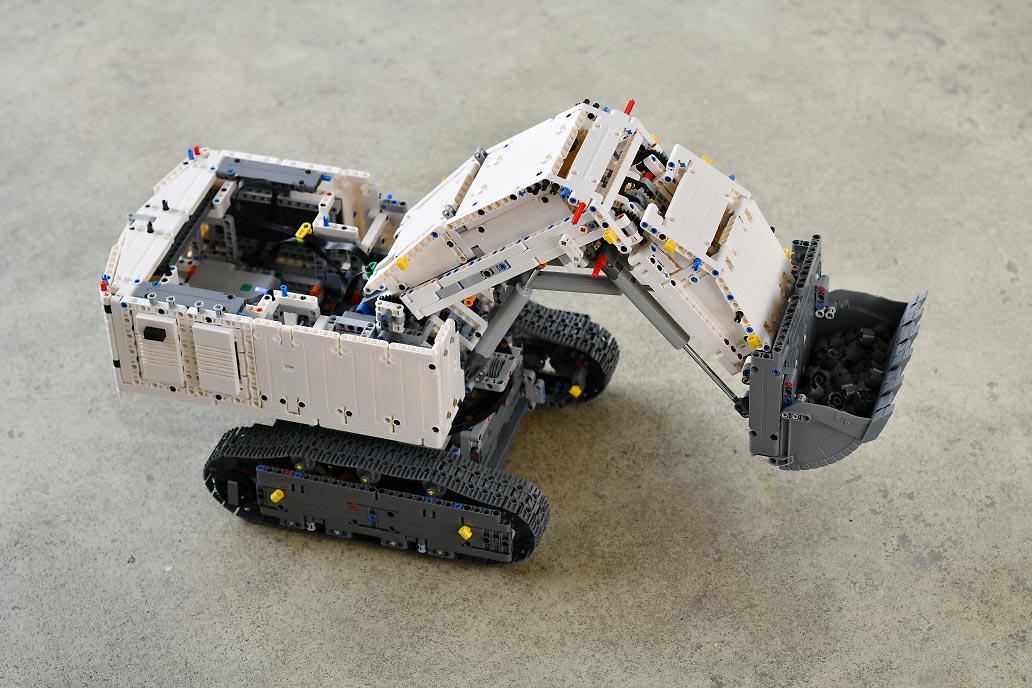
After phase 3 you basically have a working Liebherr sans operator cabin and other decoration. In my case the kids grabbed the phone and started playing with the model. I could not convince them to continue building phase 4 and 5. I did that myself. The parts from bags 4 and 5 all look very similar and it’s pretty boring to finish the last 2 building phases.
Phase 4 is basically the decoration of the main part with a operator cabin and motor/hydraulic system decorations. Here LEGO uses many classic bricks instead of Technic bricks.
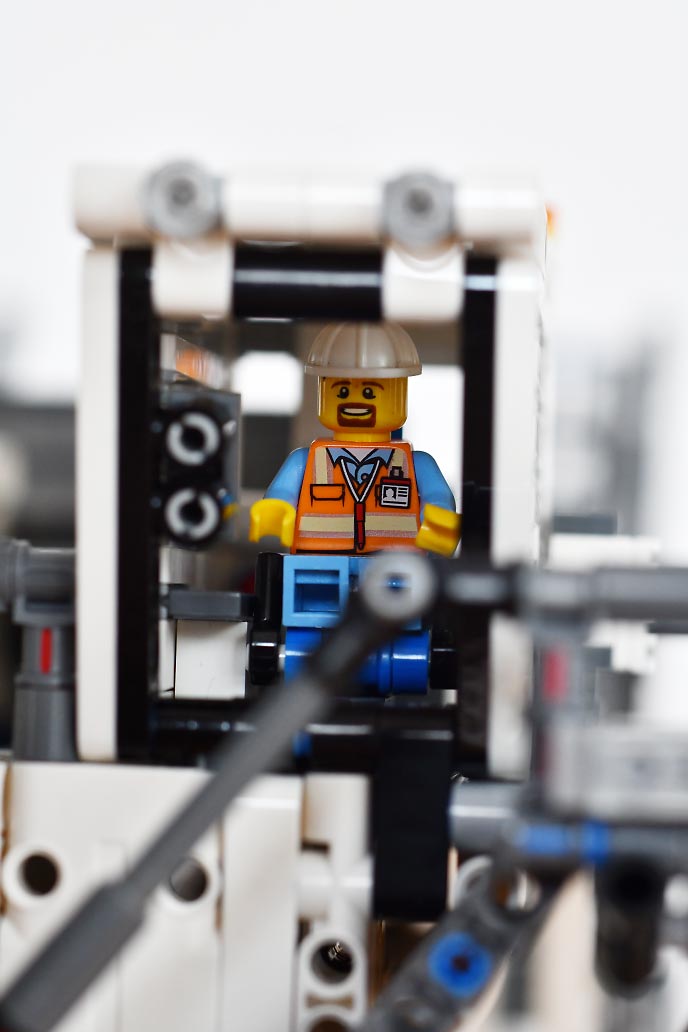
Lego man in the cabin, he fits nicely on the seat, which I made in blue. Technic seats should be blue!
Phase 5 is basically the fencing phase and you will add the fake hydraulic tubes here. Since there are so many pneumatic tubes and connectors in the set, I felt invited to try a conversion to pneumatic. The XL pneumatic cylinders are a bit shorter than the XL actuators, but they are strong enough to lift the boom, so that could be a nice challenge
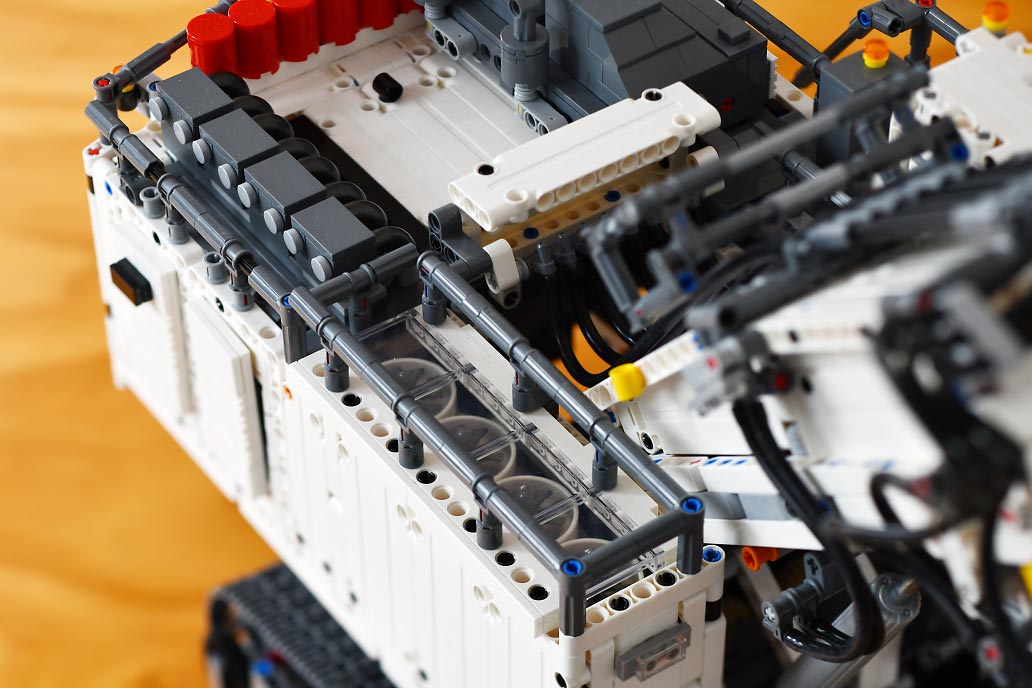
In the end you have to admit phase 4 and 5 were worth to finish. The detailing is nice.
Phase 6 is no real phase, it is just emptying a bag with 100 round bricks as play load.
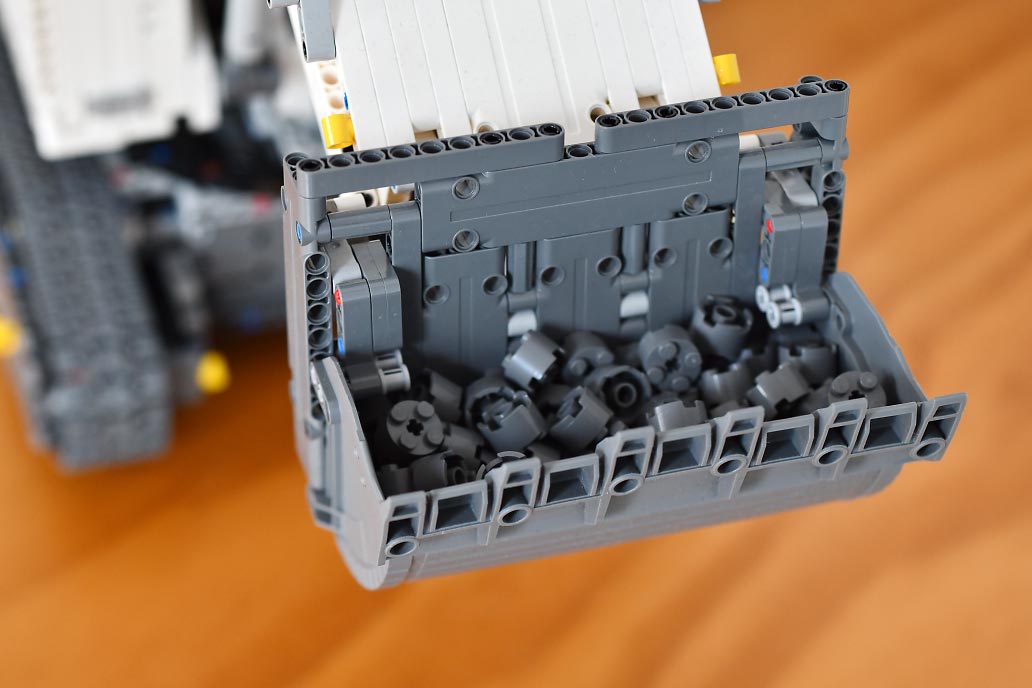
Phase 6 just fills the scoop.
Playability
Playability is a bit of a thing with the Liebherr. LEGO clearly wants to connect the attention grabbing smart phones that are the main interest of their targeted 12-16 year audience with their Technic products. To control the model you need to download the Technic Control+ app for either Android or iOS. First remark: the app is humongous. Especially on iOS. On Android it is already a pretty huge 65MB , but on iOS it is totally insane with a 463,5 MB download! No idea why the iOS version is 7 times as big. I found out that the main reason for the bigness must be some short videos of the real R9800. The difference between iOS and Android app sizes could be caused by the use different video codes. Can’t think of another reason for the big difference between the two.
If you think about programming an app to control some motors, I think 10MB should be more than enough. A light version of the Control+ app without challenges and video’s, but with customisable control layouts would be very welcome.
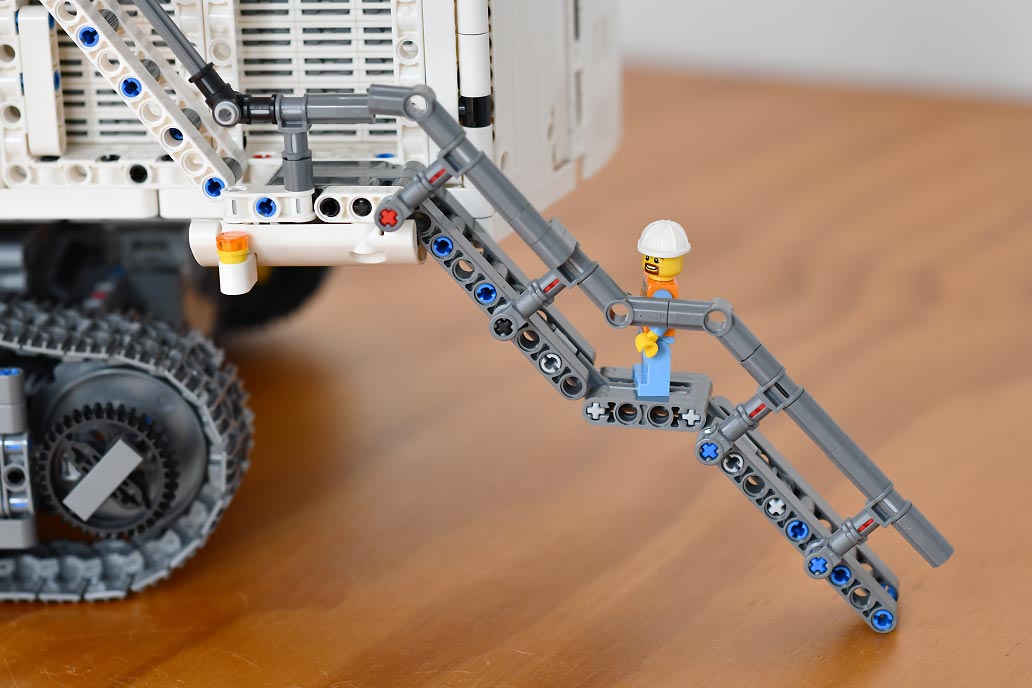
There is one single part that needs manual operation, the retractable staircase.
After the installation you can fire up the app, select the Liebherr and then you start with connecting the Bluetooth hubs. In the two days I used it I got two firmware updates for the hubs. The interval between the updates was very short. It takes about 1 minute to install a firmware update on hub 1, and then the procedure starts again on hub 2.
Now the app starts calibrating. Don’t use the app before the model is finished, or the calibration turns into a very long and noisy experience as the motors don’t “feel” the limits of the model yet.
After the firmware update and calibration process you can start playing with the model. As we’ve seen with LEGO’s other software efforts, everything is depicted with icons only. There is NO text. And that is pretty cumbersome. You have to guess what everything does. The Liebherr can be controlled in three ways. The first is with a control panel mimicking the panel in the operator cabin. It gives 2 joysticks to operate the boom and rotate it, 2 handles to drive the base similar to a tank and 2 little buttons to open the scoop. The second option gives you a side view of the arm where you can move the joints directly to the desired position. The app then calculates the needed movements of all individual actuators. The third option is with pre-programmed sequences you can construct in a Blockly-like fashion as seen in Lego Boost, EV3 and Scratch. Again without text this is pretty vague and there are no options to construct loops or enter custom amounts (time, distance, angle) in the actuator functions.
Next to the three basic controlling options, LEGO throws in a series of very simple challenges with badges as reward. I’m not entirely sure if the effect of this gamification part is to be desired. My kids were more into finishing all challenges as fast as possible than to truly operate the machine. The challenges range from driving up a hill, taking turns to load and unload tasks. But using the app to just drive around is the biggest challenge.
The main issue with the controls is that a phone does not give haptic feedback. With an old infrared controller you can watch your model while steering. With a phone that is not possible. You can’t control it without looking at your device, and that totally kills the playability. You absolutely have no idea where to push without looking. Especially the operation of the left stick to turn the boom on the base and lift the boom is very frustrating. We ended up turning the boom every time we just wanted to lift it.
Another major fail of the current Technic Control+ app is that it only allows control of the current 3 PoweredUp Technic models, and nothing else. There is no possible way to customize a control panel for your MOC, nor to fix confusing controls like we saw on the left stick.
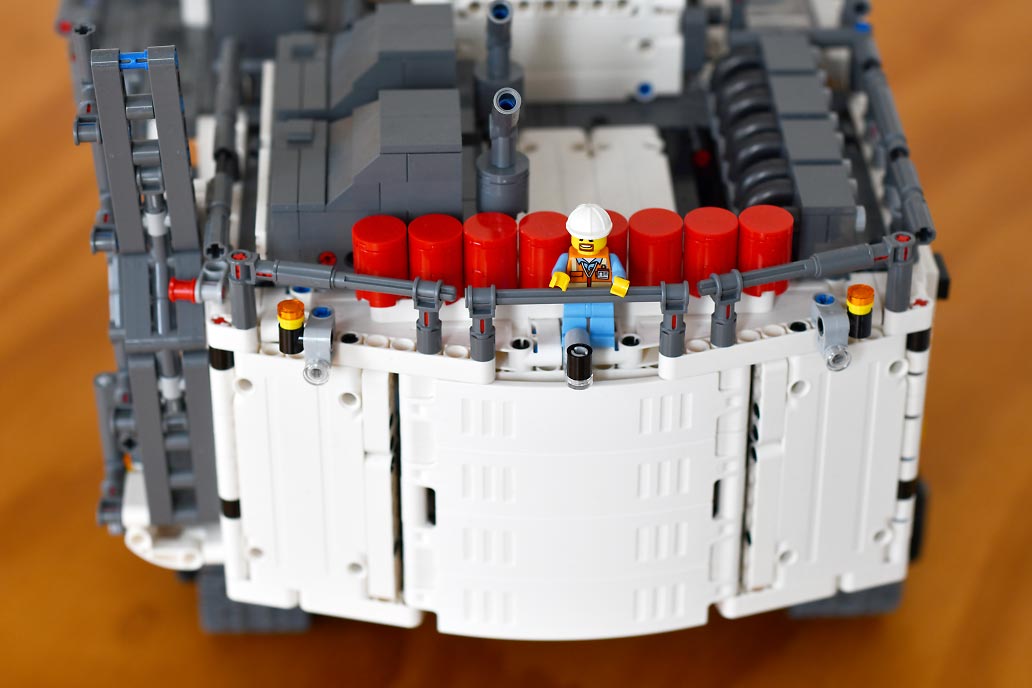
The minifig is thinking of ways to overcome playability issues by building his own controller with an Arduino.
The good thing is that the Bluetooth communication protocol is well described and easy to implement with many microcontrollers available. So just grab a Bluetooth add-on for your Arduino or grab a Microbit with built-in Bluetooth and start writing your own controlling code. Which turns your two PoweredUp hubs into a cheap Mindstorms alternative. If you add a couple of cheap Playstation thumbsticks to your Arduino you can even construct your own analogue remote control device with haptic feedback and sans restrictions on the model you can control.
By the way: yes you can turn off the hubs, but it takes patience: hold the button for over 10 seconds, first you see the LED light blue for nearly 10 seconds, then you see 3 white flashes, and then other 3 very fast white flashes. Only after that you can release the button and make the hub shut down!
I experienced some syncing issues with an iPhone. If you kept the app running in the background, and want to connect again in a new playing session by pressing the two hub buttons on setup, it will fail. You need to force-quit the app and restart it after you’ve shut down the hubs in an earlier session manually.
Last note on the playability: the Hub’s don’t get true feedback from the motors, but measure current drawn from the motor. This means that the calibrating is somewhat half-baked and not entirely stable. There is some drift in the range available on the actuators. After a while the actuators will start grinding at one end of the range. If this gets too bad, restart the calibrating procedure under the wrench icon.
Also the clutches in the base are too weak. The motors are strong enough but the clutches limit the power on the tracks so the Liebherr will have a hard time to turn around on long pile carpet. I guess the old 24 teeth coupling 3,5-6 Ncm is better suited for a torque limiting task.
Looks
The Liebherr excavator looks stunning. It is big, it is realistic looking, with nice details from the real deal, like the engines, the hydraulic system, fans for cooling, cabin details, ladders and fences.
Two minor flaws are the fake tubing and the width of the boom. On a real machine the hydraulic pipes are rather small, here they look too fat, and since they are fake it feels weird to add all these pneumatic tubes without having real pneumatic cylinders in the model. How awesome would it have been if Lego had made a dark grey pneumatic cylinder XXL, and two-way pump add-ons for the motors?
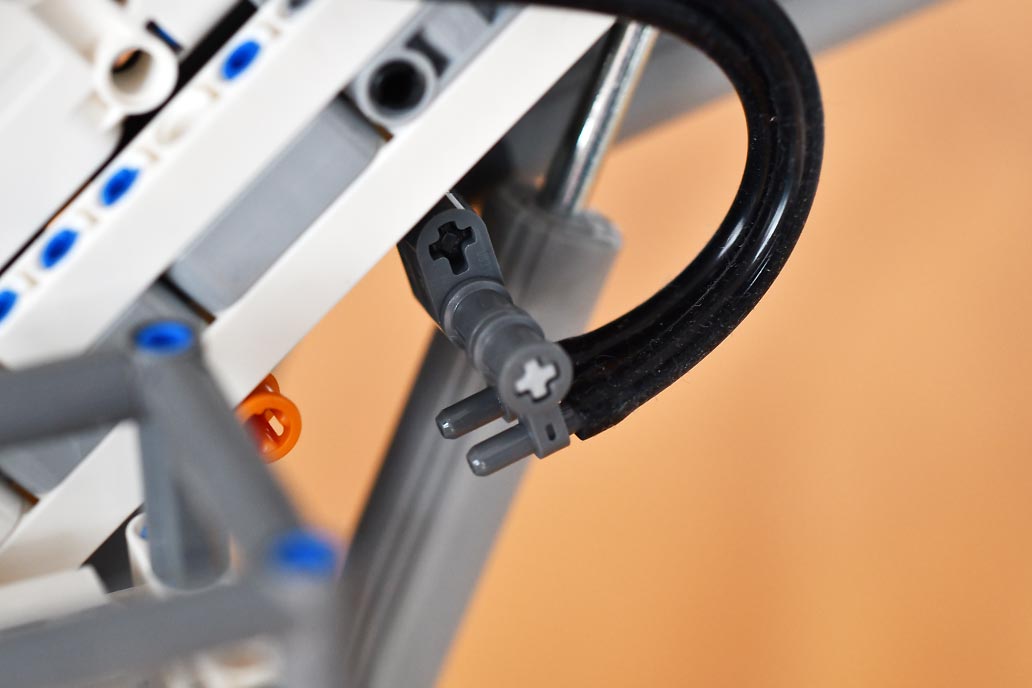
Strange dead-end on the tubes...
I felt there was some room to keep the width of the boom smaller. If LEGO would have been able to reduce it with 4 studs width it would have looked perfect.
It is nice to see a model that skips the fancy-pants colour trend a lot of Technic suffers from lately. Even though a Chiron or a Land Rover may be designed to look realistic, the problem is your Technic collection gets more and more weird colours and half complete part collections per colour. For me Technic should stick to the classic colours: White, grey, dark grey, black, red, orange, yellow, lime, green and blue. This model fits the classic colours perfectly.
Conclusion
The Liebherr 42100 is expensive, 350€ is no small price for a Technic set, but in my opinion you get value for money. You could say this model has:
- 2 SBrick equivalent hubs with internal battery compartment. These SBricks do 65€ each. Each classic battery box another 10€.
- 4 Large motors are like 12€ each, 3 XL motors like 15€ a piece.
- 6 XXL linear actuators cost like 12€ per piece when bought from LEGO.
If you add this up, the electro-mechanical components are representing a value of 315€ already. In addition to that, you get over 4000 bricks that allow you to built almost anything you want (if you have some wheels as well).
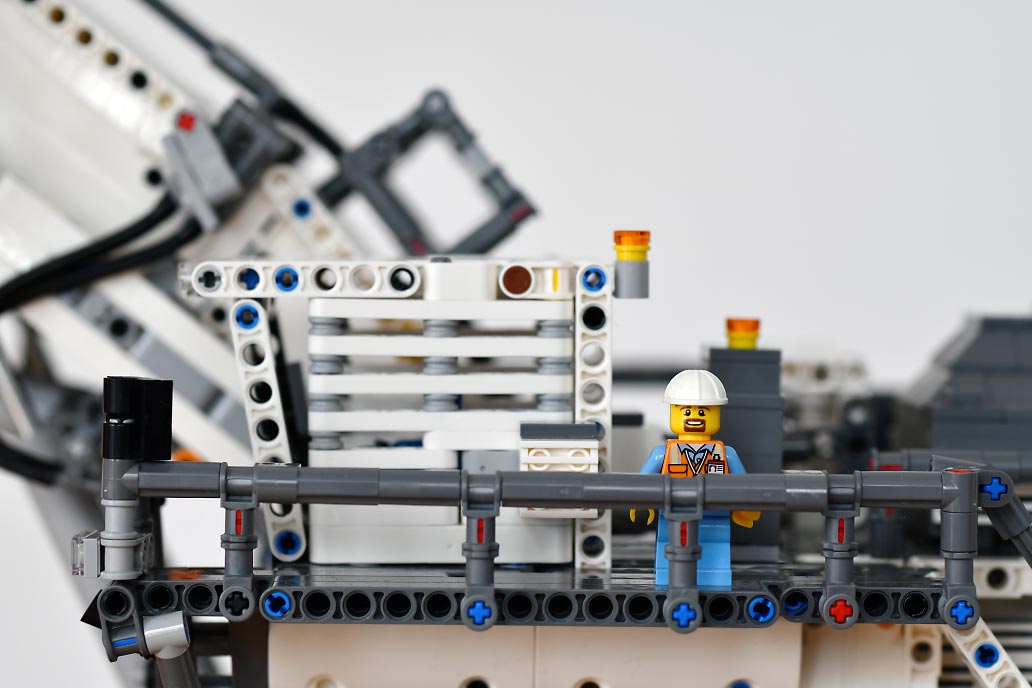
So in my opinion you get a great looking model, a decent building experience, awesome hardware (bricks, motors and hubs) and great value for money. The half baked playing experience with the app invites you to craft a real good working controller yourself, and if you get that working, it even open ups the great world of Mindstorms like robots in an even more serious way. On an Arduino or Microbit you can code in C++ or Micro Python instead of LEGO’s own crappy visual block programming.
The good
- Great selection of bricks
- 2 hubs and 7 motors give you a great start in the Powered Up system. The protocol is open and invites to develop custom controllers and EV3 like robot programming and DIY remote controllers with haptic feedback. A nice challenge for STEAM classes!
- Good value for money, 300+ euro of actuators and hubs and then some 4000+ bricks added for the remaining 50€ (don’t buy this at the RRP of 450€! It is available for 100€ less.)
- Nice building process filling a good part of a school vacation.
- Suitable for ages 7 and up. You only need to help once or twice as parent.
- Good looking, huge and realistic appearance.
- Kids love the app, so LEGO did some part of the app right: the gamification just pulls them into even more screen time.
- It looks excellent without stickers. I love it when stickers don't add much.
The bad
- The motors and hubs scratch very easily. Some already look more used than 10 year old Power Function battery boxes and motors.
- Some Bluetooth connecting issues if you forgot to force quit app after playing session.
- Very bright indicator lights on the hubs light up the whole model.
- Some rattling of actuators and clutches indicates that both the drive train is not fully up to its task and that the calibration drifts over time.
- It is hard to pick up the play load with the scoop. It works better on carpet, but that makes the drive train reach its limits more often.
- A bunch of “Where is Wally” pages in the instructions.
The ugly
- Playability with the app sucks. Without haptic feedback, this machine is nearly impossible to operate. You want to look at the action, not at your screen.
- The app has no support for MOC’s, this kills creativity.
- Insane app size on iOS. Not funny for kids who have a simple 5s or 5c from mom or dad.
Thanks martiniman!
Want to see your review on the home page? Write one and if we like what we see we'll add it!
152 likes
27 comments on this article
Seeing minifigures interact with Technic builds increases their appeal exponentially for me.
Wow, martiniman, thanks so much for taking the time to write such an in-depth & honest review!
Thanks too to Brickset for highlighting it; maybe a new news category could be 'User Review of the Week'.
Not into technic but this was a great reveiw, lots of details about the model and playability, thanks so much :)
excellent review! thanks
Phenomenal review. Stop trying to get me to spend more money on LEGO though! Seeing it scaled so well to the minifig is so awesome... Argghhhh! Ok, wait. STEM. Right, I’ll tell my wife it’s for STEM. Of course, my daughter would never go near it. One problem at a time...
I often think about making set reviews, but in fact I dare not to. First I am French so English is not my native language and even in comments it's sometimes frustrating while not finding the exact words to express points of view or feelings. I also think that pictures enhance a lot reviews and I am not equipped with what is needed to make good pics,even if I already have crafted a light box, which proves to be quite successful in providing a good quality of light... I still hesitate, maybe I lack self confidence too. But the fact that Huw tells us that users reviews have drastically decreased might push me to make the step.
Excellent review martiniman :)
"A bunch of “Where is Wally” pages in the instructions"
I'm going to pass this comment on to our building instructions team. I find it hilarious and helpful :)
@bananaworld said:
"Wow, martiniman, thanks so much for taking the time to write such an in-depth & honest review!
Thanks too to Brickset for highlighting it; maybe a new news category could be 'User Review of the Week'."
Yes that would definitely get more people into writing reviews, but, instead of writing reviews for the good of others, they might want the glory of having a nice profile And being well known. I myself have been guilty of this.
Currently, I have written 25 or so reviews when I own about 150 proper sets. That number doesn’t include my brother’s or my dad’s sets. I keep on telling myself that I need to review all of my sets for the good of all Bricksetters.
Yes, thanks! I really like that random people who write amazing reviews are appreciated. Keep it up!
I used to be a reviewer like you, but took an arrow to the knee...
All 2012 jokes aside, I stopped reviewing because the sets I became interested in were less and less (ie. Castle). Also it appeared the mods/recognized reviewers had most things covered.
As suggested above, if there was more incentive or spotlight on reviews of the week, I think you’d get more engagement and see an uptick in reviews.
I've long thought that the massive decline in writing reviews is partly the result of these featured reviews--I suspect people don't visit set pages for reviews as much as they used to, and consequently they're less likely to contribute reviews. Based on the small number of reviews I've written, they seem to be rarely read after their first few days, consistent with people not visiting set pages for reviews.
Great review.
I was given this for Christmas - parents/in-laws/wife etc all pitched in and surprised me. It's truly awesome. Well over the kids (5 & 7) heads to build, but it's the best (not fastest) thing for them to tidy away their Lego. They'll spend an hour with it scooping up Lego and dropping it in it's box.
The gamification of the app works well, they can see the instructions and learn how to use it without me having to show them.
Text reviews are, in my opinion, superior to video. Unfortunately, it seems like most of the LEGO reviews I see are poorly-written single paragraphs.
This, though, this is a very well written review. I dig it.
I too second the call for less plastic packaging. I don’t care what the solution is, but one is needed.
Great review, thanks for writing it and front paging it!
Every so often I feel like I should go through all my sets and write Brickset reviews for them, but then I set the idea aside because:
I don't have the space or equipment to take good photos
and
I'm embarrassed by how long that list of sets to review would be ....
This review is excellent! Personally, I've always preferred long-form written reviews with beautiful photos to any other type of review
Thank you , martiniman!
This was a great read, that has me seriously reconsidering my initial decision not to purchase this set.
Great review! Really liked the deeper thoughts on the set
Great review, but re:
"It dwarfs anything LEGO has made before in the Technic range, both in size and weight."
Actually, no.
Compared to 42055 and 42082, it doesn't look all that much larger. Sure, it has more pieces and weighs more, but it certainly doesn't "dwarf" these other sets.
Plus, the review clearly shows how this set is crap for the casual player as the app is more or less totally useless in its as delivered state.
Not everybody is able to or wants to tinker with third party controllers, software or completely self-programmed stuff. That this set requires such a skill set to properly operate demonstrates how badly tested this thing is.
Sure you get a lot of pieces, but for that price you better.
I will stick with my power functions powered sets, thank you.
I'm not sure about this:
"the Hub’s don’t get true feedback from the motors, but measure current drawn from the motor. "
The Control+ motors have internal position encoders so it would be logical to use those.
Yet if done without any logic in the SW the calibration would look the same - move as long as the position does not change vs move as long as the current rises.
Great to see some discussion on the weak quality control over larger Technic instruction manuals over the past several years. I can think of at least two complex models where no step ever shows the exact placement of certain parts (since the model is never viewed from a suitable angle). It seems there is no competent person at Lego responsible for checking the 'finished' instruction manual is actually complete. Either that or they run out of time and hope for the best.
Great Review! But I dont own this set so please forgive me asking what is meant by 'no support for MOCs'? is that saying that the app wont even work if you replace the modules and sensors, and why is that? Is that because the app is only dedicated to the exact layout of Liebherr? Thanks
A great review even though it isn't a set I am looking at buying (the extra expense of a new phone on top of the purchase price prohibits this) even though I am a technic builder, other recent sets give me the same problem. A guest review of the week is a good idea and might encourage others to do text reviews.
That is a very good, and well-written review, of a set that I'm not even remotely interested in.
I wish I had more time to write reviews again. I loved doing it.
Nice to read a review by someone who actually paid for the set, gives a much better impression of the value for money aspect...
I,ve used the Liebherr on two occasions for 8 hours each (with breaks for recharging) as part of an event and I haven't experienced this rattling you mention. All I could hear was the sweet VRREEEEEEEEEEEEEEEE of the motors.
Thanks for the nice comments!